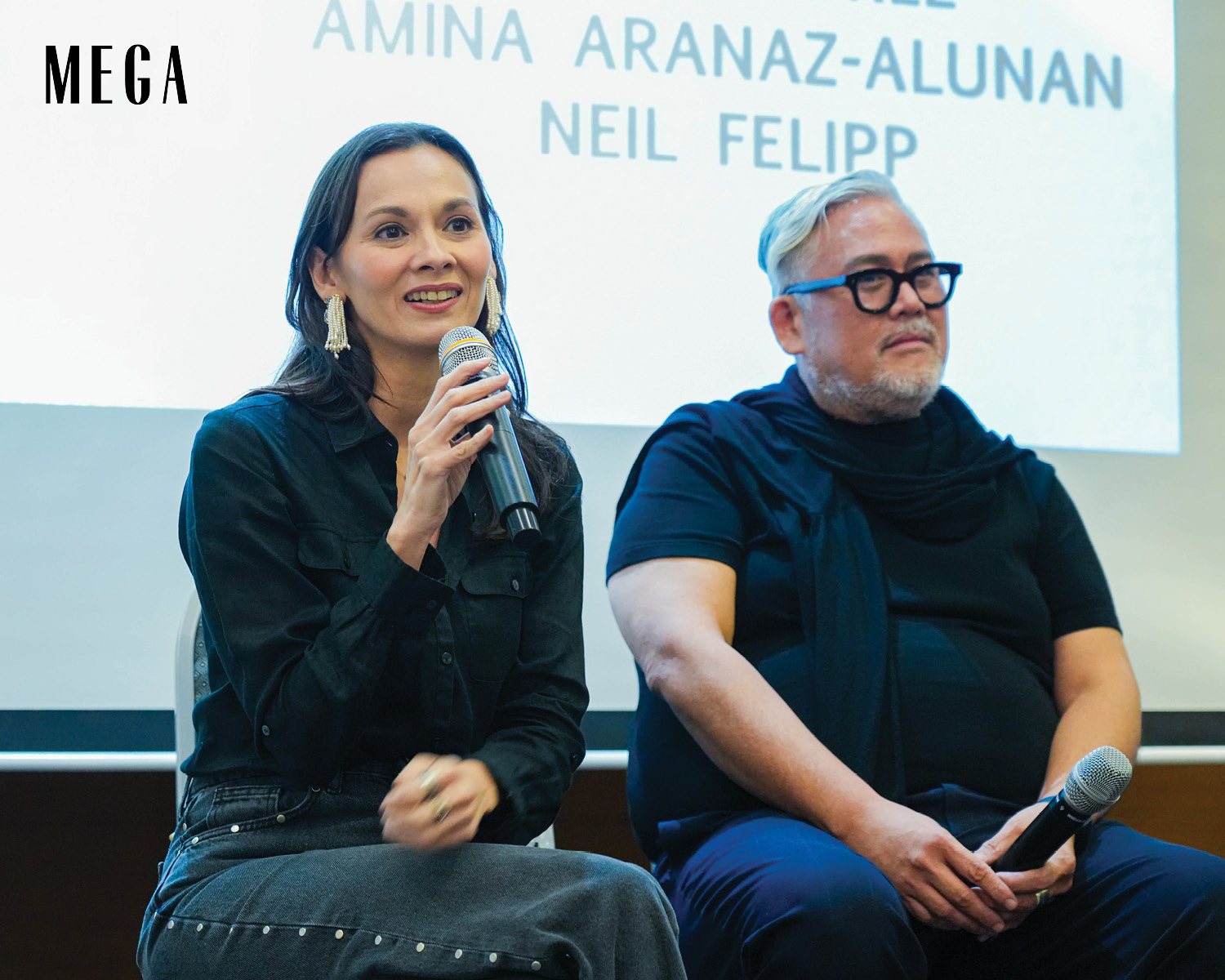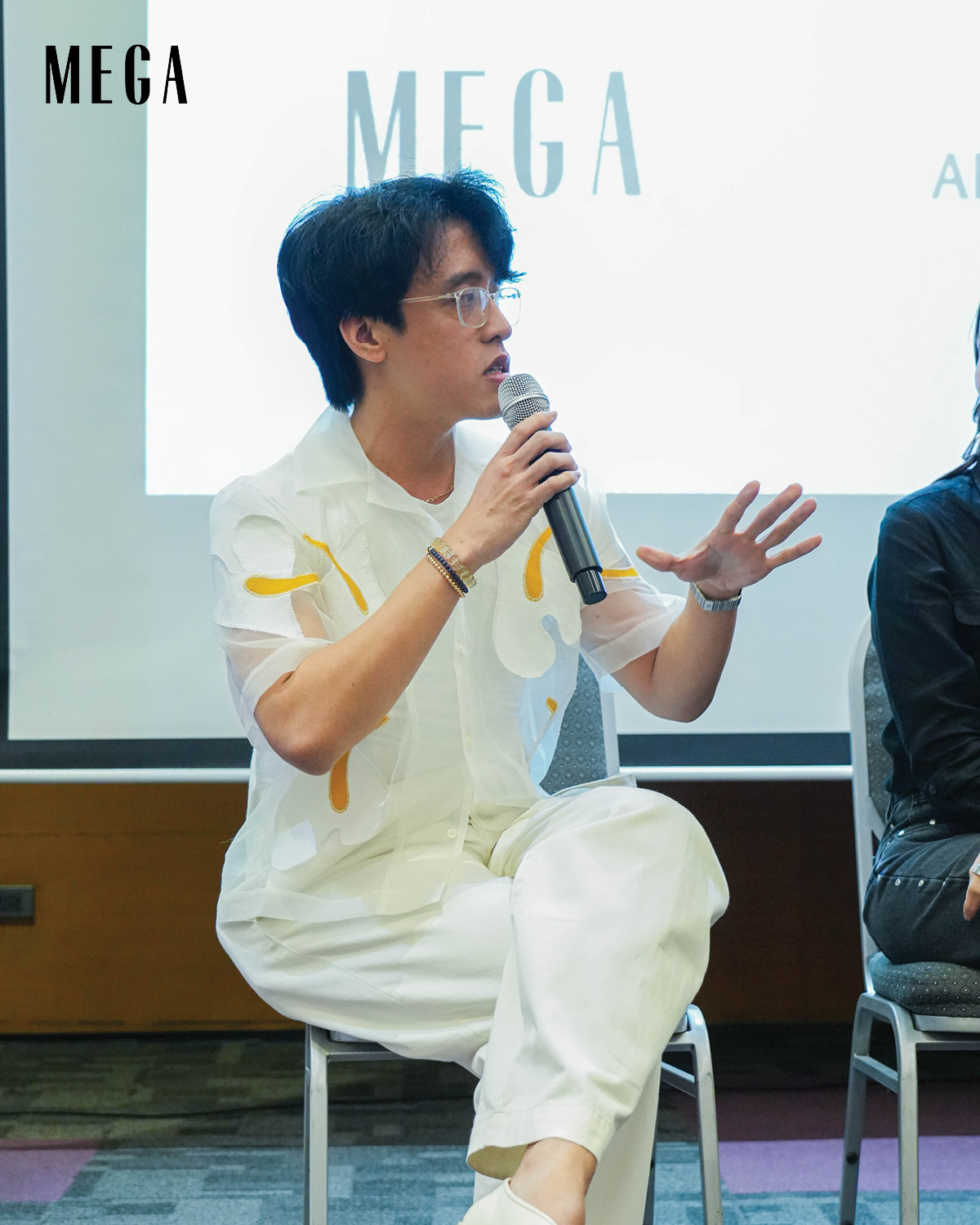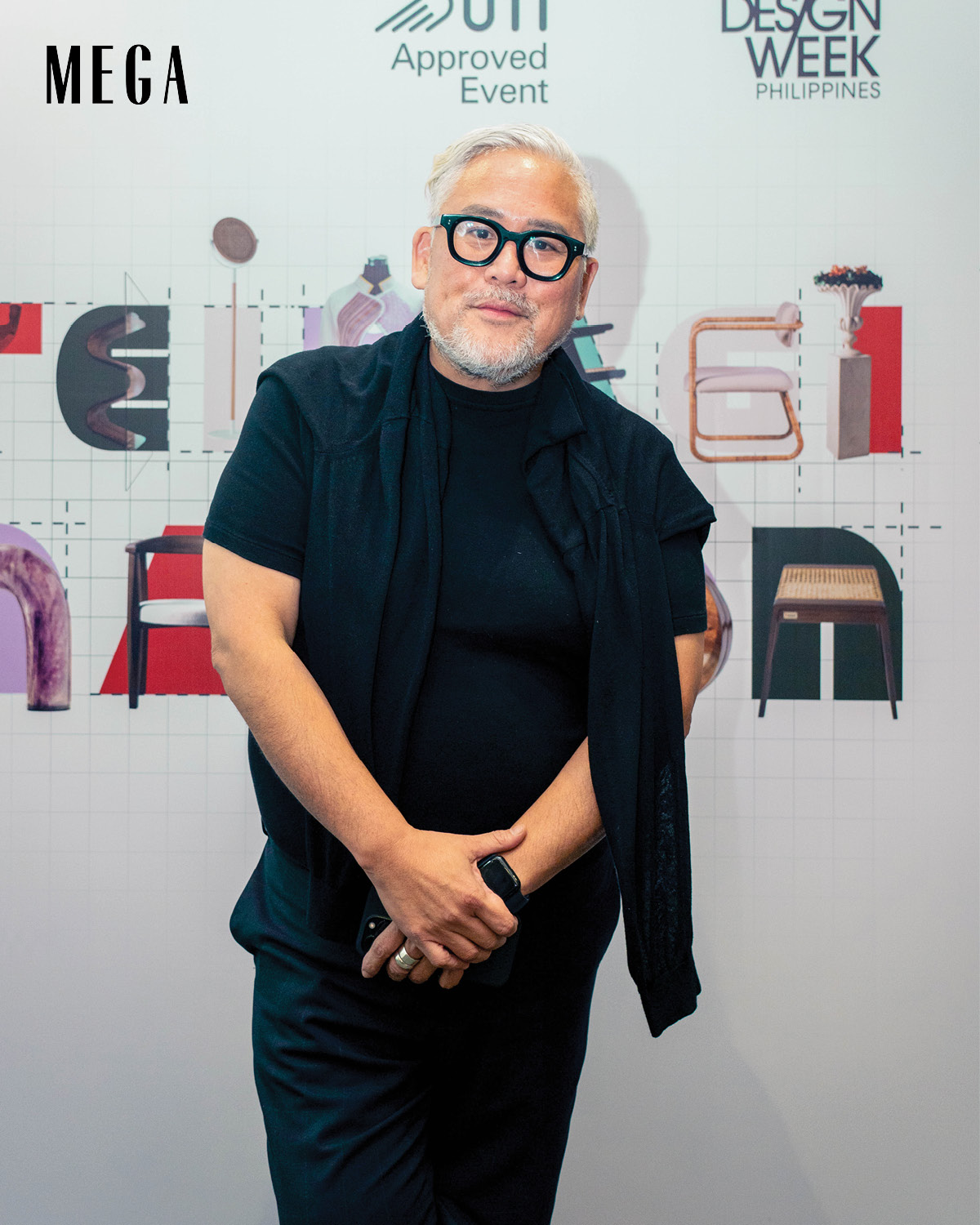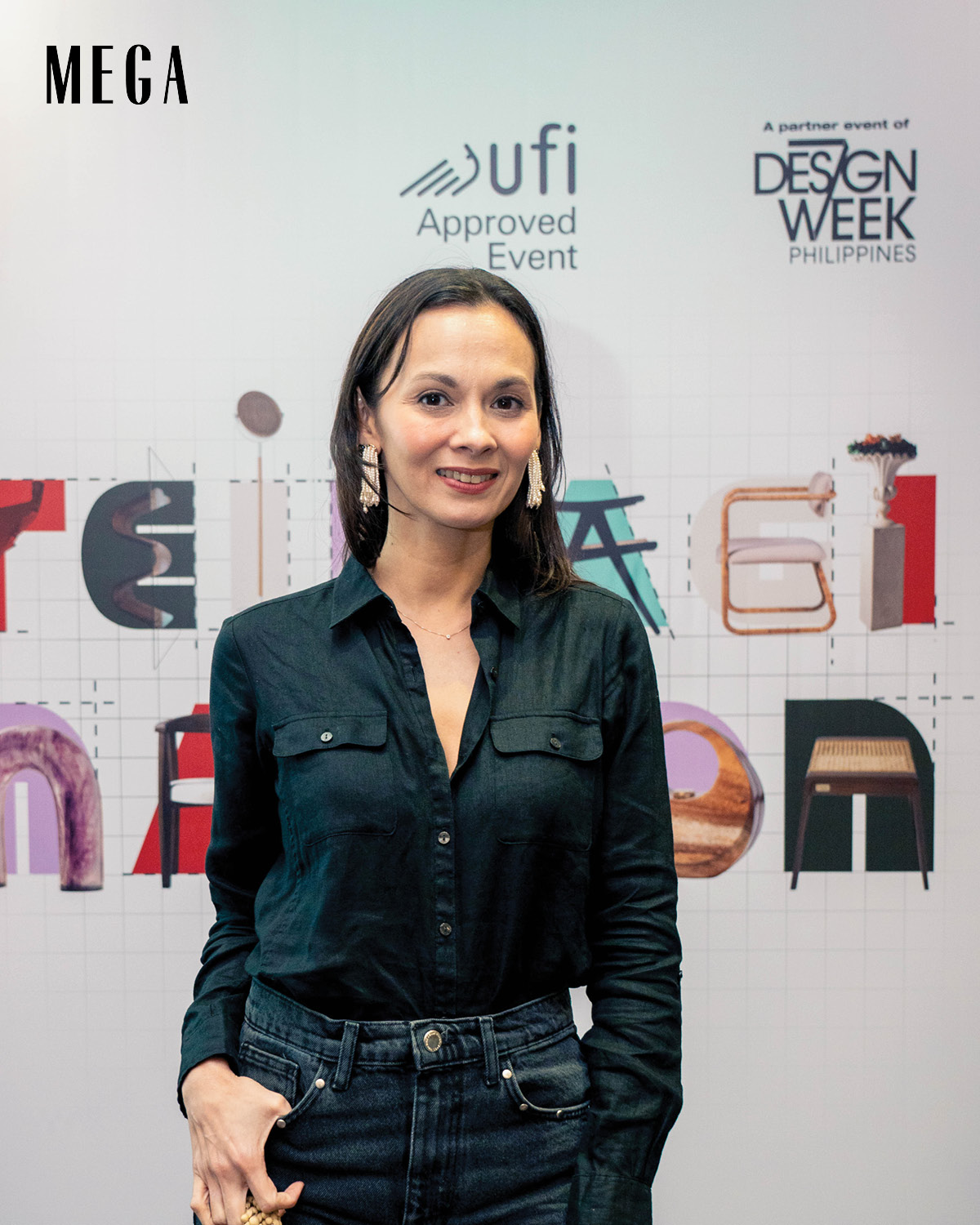Manila FAME 2024 Panel: Designers Discuss Building Globally Competitive Brands
MEGA hosted an exclusive panel discussion focused on creating a globally competitive brand, featuring esteemed designers Rajo Laurel, Neil Felipp, and Amina Aranaz
Led by MEGA Editor-in-Chief Peewee Reyes-Isidro, the Manila FAME 2024 panel in partnership with the Philippine Fashion Coalition explored essential strategies for emerging designers, by esteemed designers themselves. With over two decades in the industry, designer Rajo Laurel has refined the demi-couture and ready-to-wear markets with his acclaimed brands, including House of Laurel and RAJOMAN. Neil Felipp, recognized for his handcrafted clutches featured in the 2018 film Crazy Rich Asians, shared insights from his experience as a skilled accessories artisan. Completing the panel, Amina Aranaz has built her brand into a global name, previously available in luxury retailers like Bergdorf Goodman in New York City and Harrods in London. Together, these industry leaders offered invaluable insights into creating a brand that flourishes locally while resonating on a global scale.
RELATED: Meet the Exhibitors at Manila FAME 2024
True Callings
The panel discussion kicked off with Reyes-Isidro diving into the origins of their fashion journeys, prompting Aranaz to reflect on her early exposure to the industry.

With her family founding a bag manufacturing company right around the time she entered the world, Aranaz was practically destined for this path. Yet, she took the scenic route, venturing into publishing before finally embracing her true calling. Despite having no formal training—her college course was entirely unrelated to fashion—her determination shone through. She candidly recounted her applications, which included an ambitious pitch to work as a fashion designer for Penshoppe, despite her lack of drawing skills. “I was so kapal,” she laughed on how she threw herself into the fashion job hunt, including luxury retail group SSI, landing a job in publishing while simultaneously nurturing her dreams for ARANÁZ.
Laurel chimed in, noting that he had been in the industry for over three decades. His humble beginnings involved crafting prom dresses for classmates, thanks to his grandmother’s in-house seamstress. “I really started small,” he admitted, mentioning his fortuitous hire at SM as a teenager. “They didn’t realize I was just 15 because I was so big and tall!” he chuckled, reminiscing about that first paycheck of 5,000 pesos, which felt monumental at such a young age.
Felipp recalled his initial foray into fashion at the tender age of six or nine. He remembered disliking the outfit his yaya wore and expressing his desire for her to look beautiful. “She was my second mother,” he said, emphasizing the affection that fueled his creative spark. After completing his studies at UP Cebu, drawn by the opportunity to learn under Kenneth Cobonpue, Felipp took the plunge into design, eventually launching his own studio. “That was the best decision I ever made,” he remarked, even if it led him to realize that furniture design wasn’t his true calling.
Retail Therapy
As the discussion flowed, Reyes-Isidro shifted the focus to the panelists’ transition into retail. Aranaz dove in first, explaining that for handbags, retail was the natural avenue. With a strong manufacturing background supporting her ability to produce in bulk, she saw retail as the way to get her products into the hands of consumers.

Aranaz’s sojourn in Milan was a revelation, an awakening amid the city’s energy. “When I was there, living in a fashion capital, I really saw how fashion brands operate and how it’s everywhere,” she reflected, her enthusiasm bubbling over. That revelation ignited a dual dream: not only to carve her own niche but to elevate Filipino designers. “I also feel that ready-to-wear is also how you can export, and how you can make a mark on the global stage,” she declared, her voice steady but laced with a hint of exasperation. The absence of Filipino brands in malls gnawed at her, making each new store opening a personal victory. “Every time I see a new Filipino brand open a store, I get excited,” she admitted, recalling her early days in Greenbelt, where the Filipino zone flourished and fostered a community of creators.
Laurel followed up with a nod to family influence, sharing that his venture into retail was largely due to his sisters’ impatience. “My sisters were tired of waiting for their clothes,” he chuckled, admitting that his made-to-order model meant customers often faced long wait times. “So, we organized a workshop to streamline the process, and that’s how we grew into retail.” His casual approach and organic growth echoed his heartfelt connection to family. When Rockwell approached him about opening a store, he found himself diving into retail almost by necessity. “Let me ask my sister,” he said, recalling how their family’s need for immediacy shaped the business.

Felipp noted that, for him, retail was all about creating an experience. Having only entered the retail space a few years ago with his flagship store, he was now expanding with pop-ups and his third boutique at the Peninsula Hotel, where his bags—and artworks—hold a story. “When you go to a Rajo store, when you go to an ARANÁZ store, you are immediately brought into this whole experience.”
Branding Banter: Persona and Product
As Reyes-Isidro steered the conversation toward branding—the lifeblood of perception—Felipp emphasized the distinct personalities of his brand and himself. “I’ve always wanted to make it clear that the brand, Neil Felipp, and then me as the individual are two different people, and I’d rather have it that way,” he articulated. “As the perception for people, they’ve always seen the brand as something of an ethereal elegance. It’s something dreamy. It’s something, as we say, luxurious,” he continued, infusing his brand with aspirations of timelessness. With his playful wit, he showcases how that lightheartedness fuels his artistic endeavors.
Aranaz painted her brand as a celebration of leisure, a sanctuary from the rush of daily life. “For me, the brand is really about celebrating a leisurely life,” she shared, conjuring sun-soaked afternoons. “It’s a leisurely life, but it’s also about what we use a lot in our Instagram…with love from the Philippines,” she emphasized. “We say that our pieces are a sense of escape.” Every woman that wears it is transported, whisked away in her imagination, bridging the gap between the every day and the idyllic.
Laurel, with warmth and humor, asserted the intimate connection between his identity and his brand. “My brand is me. Essentially, I cannot remove who I am from what I make,” he declared, each creation a mirror reflecting his experiences. “I would like to say that our brand is like our friend…It’s an extension of our family because I really work very closely with my family,” he explained a glimpse into his collaborative spirit, colored by familial bonds. “Sometimes, I’m happy. Sometimes, I’m sad. Sometimes, I like things… it comes out regardless of what we like it or not because it’s who we are,” he concluded, embracing the messiness of life that makes his creativity.

The vision of these designers for their brands was personal and expansive, reflecting their aspirations and the audience they sought to attract. For Laurel, the dream began with supermodels like Kate Moss, embodying an ideal client that would continuously evolve. “Of course, the people we idolize, the people we’d like to dream about,” he reflected, aiming to dress a diverse spectrum of individuals. His latest collection, RAJOMAN, was a foray into redefining masculinity, embracing the fluidity of identity, and recognizing the rich diversity within the gender spectrum.
Aranaz took a different route, born from her roots in manufacturing for foreign brands. She recalled the frustration of seeing her factory’s creations celebrated in magazines without recognition for their Filipino heritage. “I felt bad that the Filipina did not have access to that kind of product,” she lamented. Her mission crystallized around the Filipina fashionista, introducing her audience to stylish pieces made from local materials, aiming to show that something native could hold its own against international labels. “We managed to design pieces that appealed to a market and introduced Filipinos in a new way,” she noted, emphasizing her long-term dream of reaching a global audience.
For Felipp, his designs are inspired by family ties. “I wanted it to be a timeless audience,” he explained, noting that his earliest designs were crafted for his mother and grandmother. He aimed to create pieces that would resonate across generations, ensuring that each creation remained relevant over time. “That at least it’s not going to be wasteful. It’s always considerate,” he asserted.
Handmade Heartbeats
The distinct essence of Filipino design shines brightly, as Aranaz reflects on the heart imbued in each handmade piece. “Customers say that in Filipino products, they see heart in the handmade, heart in the materials,” she recounted, noting the undeniable rawness and authenticity that sets their creations apart. It’s a unique alchemy of climate and creativity; the sun-kissed natural materials lend a character to their work that cannot be replicated. Despite the challenges of manual processes and the elements, she proudly champions the soul in Filipino craftsmanship.

Felipp mirrored this sentiment, emphasizing the unmatched quality of their artistry. “There’s really a soul with every thread, with every carving,” he declared, lamenting that many struggle to believe in the excellence of Filipino-made products. He urged a shift in narrative, advocating for pride in their capabilities to compete with renowned luxury markets like Japan, Italy, and France. “We are designed for luxury craftsmanship,” he said, calling for a collective recognition of their heritage.
Laurel added another layer, acknowledging the bespoke nature of Filipino design. “We intrinsically create for one of a kind,” he noted of the offering amidst a global landscape dominated by mass production. With the industry awash with the mundane, the craftsmanship of Filipino artisans evokes individuality—a contrast to the sea of sameness. He also remarked on the joy found in collaboration and on the infectious spirit that comes from working with fellow Filipinos. “We’re the loudest. We’re the happiest,” he mused, suggesting that our camaraderie adds an undeniable energy to their creations.
Sustainable by Nature
Sustainability often feels like a buzzword tossed around without substance in this day and age, and the designers reveal a different narrative: their commitment to sustainable practices is adhered to in their operations.

Laurel explains, “Our business model has always been sustainable, primarily because we only make when we’re ordered. So, it’s one-to-one.” This method ensures that every piece crafted is not merely produced, but thoughtfully created. “When it runs out, that’s it,” he adds an ethos that thrives on limited runs rather than excess gas. Their approach is a return to the roots of craftsmanship, where smaller scales mean less waste and a direct line to consumers. “We are sustainable because of that nature,” thus highlighting a system that respects both the artisan and the environment.
Aranaz describes her brand’s long-standing relationship with sustainability. “The materials we use are always natural. We go through natural processes.” Her company has a history of collaborating with local communities, a practice started by her mother in the ’70s. “It’s always been a conscious effort to work with local materials,” she says, revealing that this commitment predates the modern sustainability movement. “It wasn’t even because there was a concept of sustainability. But it’s intrinsic in what Filipino craftsmanship is about.”

Felipp adds to this dialogue, recognizing that the industry’s limitations have unintentionally fostered sustainable practices. “Our industry, way before the word sustainability, we were technically doing it,” he states. “But at the end of the day… sometimes it’s just better to be where you are. Because you’re much happier.” He recalls the pressure to deliver 1,000 bags to Bergdorf’s in three months and questions the impact of such demands on the psyche of his team. “Is this what you really want?” he asks, inviting a deeper contemplation of sustainability that taps into emotional and mental well-being.
Seeds of Success
The conversation shifts to the essential topic of nurturing emerging talent within the Filipino fashion landscape. Reyes-Isidro stresses the role of Manila FAME in uplifting craftsmanship and the need for local support: “How can we Filipinos support brands and designers who are only starting to gain a footing in business?”
Aranaz, with an eye on the digital horizon, asserts, “Look at the world of online.” The pandemic has shifted consumer habits, making online shopping not just a convenience but a necessity. “Before, my online sales weren’t something I focused on, but now customers are comfortable shopping online,” she explains. For budding designers, she advocates a low-cost approach to establishing a presence: “It’s a way to grow your business without the hefty investment of a brick-and-mortar store.” Yet, she accentuates the importance of balancing creativity with pragmatism: “As much as I am a super duper creative, you have to discipline yourself to take a look at the numbers.”
Felipp offers a candid piece of advice: “Don’t start a brand yet.” He champions the value of apprenticeships, urging newcomers to learn from established designers. “My three years with Kenneth Cobonpue taught me more about the business of design than just design itself,” he recalls the necessity of understanding the intricacies of the industry. “Find a veteran designer you admire and be kapal—be bold enough to ask for an apprenticeship.”
Laurel says, “I’m very proud that the people who used to work with me have their own stores now.” He looks to Felipp’s sentiments, reminding aspiring designers to pause and reflect. “What business do you really want to do?” He recognizes that not everyone has to be a designer; there’s room for various roles within the fashion ecosystem. “What gives you the most joy? Is it taking pictures? Making content? Writing?” He believes that finding one’s niche is key to thriving in this community.

Felipp concurs, reinforcing the message with a call to action: “Do the work. Do the work.” The mantra resonates that success is rooted not just in talent, but in the dedication and effort one puts forth.
Ultimately, creating globally competitive Filipino brands hinges on authenticity, sustainability, and collaboration. Designers like Rajo Laurel, Neil Felipp, and Amina Aranaz stress that real impact arises from honoring our heritage while embracing innovation. Their commitment to nurturing talent and celebrating craftsmanship calls on us to support this community and envision a future where Filipino fashion resonates deeply and stands confidently in the global market.
Special thanks to DTI, CITEM, Manila FAME, and FASHION COALITION OF THE PHILIPPINES
Photographed by KIERAN PUNAY
The post Manila FAME 2024 Panel: Designers Discuss Building Globally Competitive Brands appeared first on MEGA.Manila FAME 2024 Panel: Designers Discuss Building Globally Competitive Brands
Trending Updates Central

No comments: